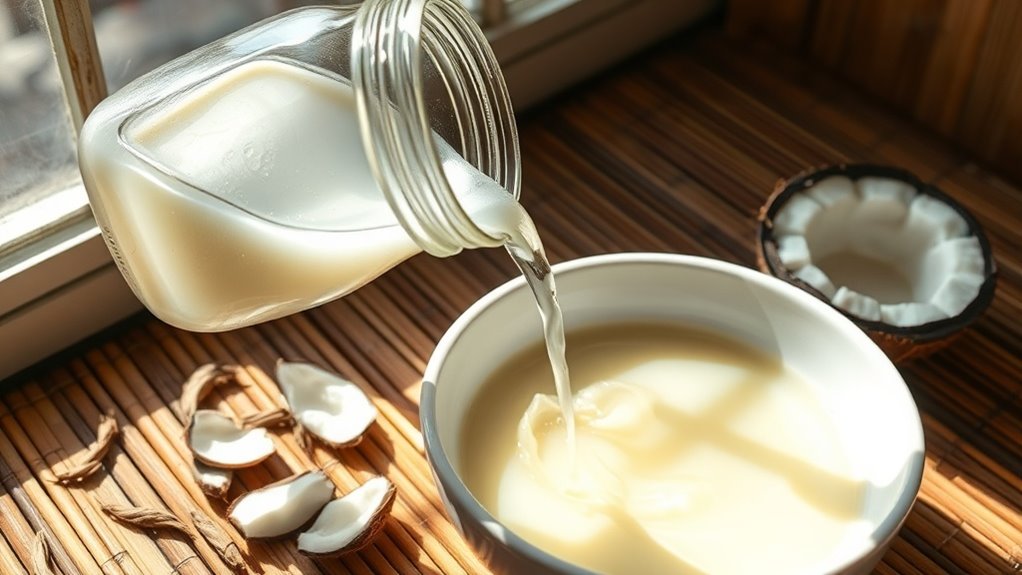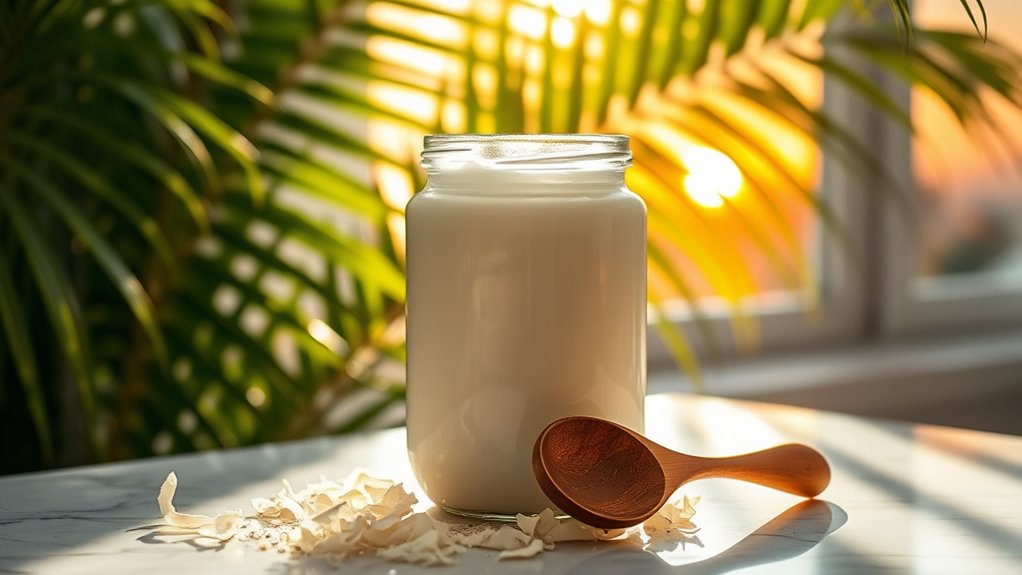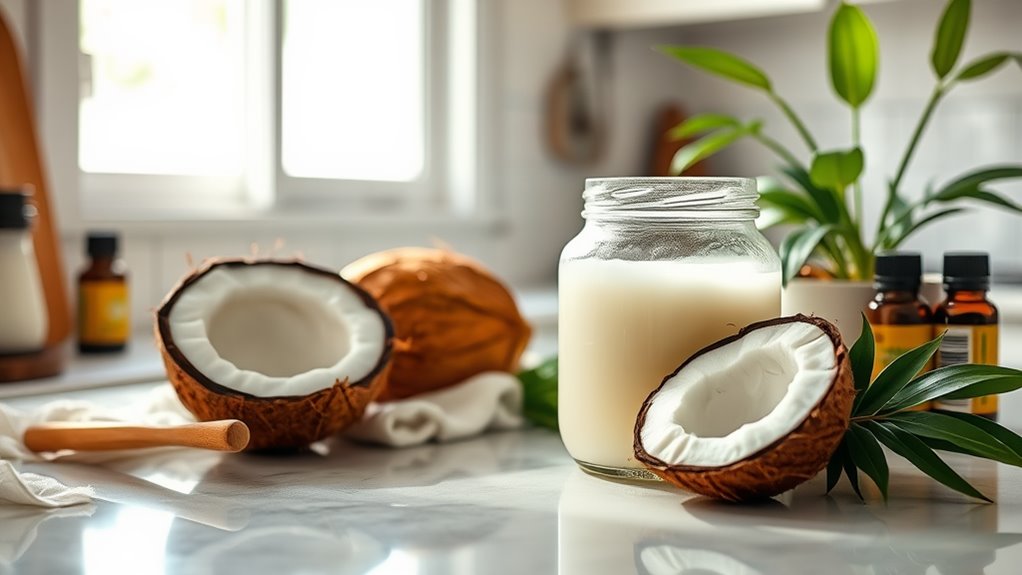Frizzy Hair Fix- Coconut Oil Trick You’ll Want to Try
You can tame frizzy hair naturally by using coconut oil’s unique molecular structure and deep-penetrating properties. The oil’s medium-chain fatty acids bind to hair’s keratin proteins, creating a protective shield against humidity while sealing the cuticle layer. Apply warm coconut oil to clean, dry hair in sections, focusing on mid-lengths to ends, and leave it overnight for best results. Learn how to maximize this proven frizz-fighting treatment with expert application techniques and combinations.
Key Takeaways
-
Coconut oil’s medium-chain fatty acids penetrate deep into hair shafts, creating a protective barrier against humidity and frizz.
-
Apply warm coconut oil to dry, sectioned hair from roots to tips, focusing extra product on damaged areas.
-
Use only 1 teaspoon of oil and concentrate application on mid-lengths to ends to avoid excessive greasiness.
-
Leave treatment overnight wrapped in a cotton t-shirt or plastic cap, using a silk pillowcase to prevent friction.
-
Regular application 2-3 times weekly improves hair texture and manageability while reducing protein loss and damage.
Why Frizzy Hair Happens and How Coconut Oil Helps
Have you ever wondered why your hair suddenly turns into an unruly mess on humid days? When moisture penetrates your hair’s cuticle layer, it causes swelling and frizz. While humidity is a major culprit, your genetics, washing habits, and environmental factors also play significant roles in creating frizzy hair. Friction during towel drying can also cause your hair to become frizzy by roughening the hair shaft’s scales.
Among popular frizzy hair remedies, coconut oil stands out as a natural solution. It works by forming a protective barrier around your hair shaft, preventing excess moisture from entering while locking in essential hydration. This remarkable oil smooths the cuticle layer, repairs damage, and nourishes your strands with vital nutrients. By penetrating deep into the hair shaft, coconut oil helps maintain moisture balance and reduces the likelihood of frizz, even in challenging weather conditions. Additionally, it contains medium-chain fatty acids that enable deep penetration into the hair.
The Science Behind Coconut Oil’s Frizz-Fighting Power
The remarkable frizz-fighting power of coconut oil lies in its complex molecular structure and unique chemical properties. Its medium-chain fatty acids, particularly lauric acid, bind directly to your hair’s keratin proteins, creating a protective shield that strengthens each strand from within. Studies indicate that frizz occurs when the cuticle layer of hair is lifted and roughened, making this oil’s benefits even more significant.
You’ll find coconut oil’s hydrophobic nature works to your advantage by forming a moisture barrier that prevents excess water absorption while maintaining your hair’s natural hydration levels. The oil’s low molecular weight means it’ll penetrate deep into your hair’s cortex, filling structural gaps and reducing porosity. This is especially beneficial in humid climates where hair is most prone to swelling and frizzing.
This penetrative action helps seal lifted cuticles, leading to smoother, more manageable hair that’s less prone to frizz. Recent clinical studies confirm that coconut oil outperforms commercial products in reducing mechanical damage and improving hair elasticity.
Step-by-Step Guide to Using Coconut Oil for Frizz Control
Transform your frizzy hair into smooth, manageable locks by following a strategic coconut oil application process. Start by ensuring your hair is clean and dry, then warm the coconut oil in a water bath until it’s liquid. Divide your hair into manageable sections and brush out any tangles.
Apply the warmed oil between your palms, then work it through each section systematically, focusing extra attention on dry ends. The oil acts as a powerful natural sealant to lock in moisture and prevent frizz throughout the day, thanks to its molecular structure that penetrates deep into the hair shaft.
Use a wide-toothed comb to distribute the oil evenly from roots to tips.
For best results, leave the treatment on overnight, covering your pillow with a towel.
If you’re short on time, let it sit for at least 30 minutes before washing.
You’ll notice immediate improvement in texture and manageability, with continued benefits through regular application.
Best Ways to Apply Coconut Oil Without Making Hair Greasy
To avoid greasy-looking hair, you’ll want to use no more than 1 teaspoon of coconut oil unless your hair is exceptionally thick or dry. Applying coconut oil minimizes protein loss, which can lead to healthier strands and less frizz. You can maximize the oil’s benefits by applying it in the evening and leaving it on overnight, which allows proper absorption without daytime residue. Make sure you’re sectioning your hair before application and focusing the product on your mid-lengths to ends rather than your scalp to prevent unwanted oiliness. This technique is especially beneficial for those with dry, curly hair, as coconut oil provides intense hydration for these hair types.
Application Amount Matters
Many people struggle with finding the right amount of coconut oil to use on their hair, often ending up with either too little product to be effective or so much that their locks become weighed down and greasy.
To get it right, start with a small amount of virgin or cold-pressed coconut oil and adjust based on your hair type. If you’ve got fine hair, you’ll need less than someone with thick, coarse strands. Apply the oil to damp hair, focusing on mid-lengths to ends, and use a fine-tooth comb to distribute it evenly. Using coconut oil helps prevent protein loss in your strands while moisturizing. You’ll know you’ve used the right amount when your hair feels moisturized but not heavy. Remember to only apply coconut oil when your hair actually needs it – when it’s feeling dry or particularly frizzy.
Timing Your Oil Treatment
When you time your coconut oil treatment strategically, you’ll maximize its frizz-fighting benefits while avoiding that dreaded greasy look.
Evening application proves most effective, allowing 6-8 hours of deep penetration during sleep without daytime oiliness.
For shorter treatments, aim for at least 30 minutes pre-shampoo to ensure proper absorption.
-
Apply warm oil using the double-boiler method, testing the temperature on your wrist before massaging it through your mid-lengths to ends
-
Secure treated hair with a cotton t-shirt wrap or plastic cap to prevent oil transfer onto pillowcases during overnight treatments
-
Time treatments 2-3 times weekly for moderate dryness, adjusting frequency based on your hair’s porosity and seasonal humidity levels
Fine hair? Limit application to 30 minutes to maintain volume and prevent weighdown.
Tips for Overnight Coconut Oil Treatment
Before applying coconut oil overnight, you’ll need to thoroughly detangle your hair and section it into manageable parts to ensure even distribution of the oil. Once you’ve applied the oil and wrapped your hair in a protective cap or scarf, choose your sleeping position carefully to prevent oil from seeping onto your face or pillowcase. You’ll get the best results by sleeping on your back or using a silk pillowcase that won’t absorb the oil from your hair treatment. Additionally, coconut oil penetrates deep into the hair shaft, making it an effective solution for frizzy hair.
Prep Your Hair First
Preparing your hair properly before an overnight coconut oil treatment ensures maximum absorption and effectiveness.
You’ll want to start with slightly damp hair using a spray bottle, then divide it into manageable sections for easier application.
Focus on applying more oil to your dry or damaged ends while using less near your scalp to prevent greasiness.
- Section your hair with clips, working methodically from bottom to top
- Gently massage the oil into each section, ensuring even distribution through every strand
- Use your fingers or a wide-tooth comb to work the oil from roots to tips, paying special attention to damaged areas
Remember to choose virgin or cold-pressed coconut oil for optimal results, and ensure it’s free from additives. Warm the oil slightly if needed, but avoid using hot oil that could damage your strands.
Sleep Position Matters
How you position yourself during sleep can significantly impact the effectiveness of your overnight coconut oil treatment. Back sleeping is your best option, as it minimizes direct pressure on your hair and helps preserve the oil’s nourishing properties throughout the night.
If you’re a side or stomach sleeper, you’ll want to adjust your sleeping position since these postures increase compression on your hair strands, which can lead to premature oil removal and unnecessary friction.
To maximize your treatment’s benefits, pair your back-sleeping position with a silk or satin pillowcase and secure your hair in a loose braid using a soft, non-metallic hair tie. This combination will help distribute the oil evenly while preventing tangles and frizz that often result from tossing and turning.
Combining Coconut Oil With Other Natural Ingredients
While coconut oil works wonders on its own, combining it with other natural oils and butters can amplify its frizz-fighting benefits.
You’ll find that strategic combinations target multiple hair concerns simultaneously while maximizing moisture retention and cuticle protection.
-
Mix coconut oil with argan oil for a lightweight serum that smooths your cuticles and provides heat protection before styling.
-
Blend coconut oil with shea butter for an intense overnight treatment that repairs severely damaged strands and improves elasticity.
-
Combine coconut oil with avocado oil for a nutrient-rich mask that strengthens follicles while adding remarkable shine; this blend utilizes medium-chain fatty acids for enhanced moisture retention.
These natural combinations work synergistically to combat frizz through deep moisturization, enhanced nutrient delivery, and improved cuticle sealing.
You’ll notice smoother, more manageable hair with regular application of these targeted blends.
Common Mistakes to Avoid When Using Coconut Oil
Despite coconut oil’s remarkable benefits for frizzy hair, improper application techniques can diminish its effectiveness and create unexpected problems. You’ll want to avoid common pitfalls that can turn your hair treatment into a styling nightmare.
| Mistake | Solution |
|---|---|
| Applying to wet hair | Use on dry hair for better absorption |
| Using too much oil | Start with a small amount, focusing on ends |
| Poor timing | Plan treatments when no styling is needed |
When treating your hair, don’t leave the oil on without covering your pillow during overnight applications. Remember to thoroughly wash out the oil to prevent residue buildup that can trap dirt and clog pores. If you’re prone to scalp sensitivity, be cautious as coconut oil’s comedogenic nature might cause irritation or acne. Adjust your application frequency based on your hair type and monitor how your scalp responds to treatments.
References
- https://www.medicalnewstoday.com/articles/324563
- https://pumphaircare.com/blogs/tashs-blog/is-coconut-oil-good-for-hair
- https://www.verywellhealth.com/coconut-oil-for-your-hair-4171883
- https://www.healthline.com/health/coconut-oil-hair-mask
- https://controlledchaoshair.com/blogs/curly-hair-news/is-coconut-oil-good-for-curly-hair
- https://www.medicalnewstoday.com/articles/how-can-i-stop-my-hair-from-frizzing
- https://www.healthline.com/health/beauty-skin-care/what-causes-frizzy-hair
- https://www.livingproof.com/hair-101/why-is-my-hair-so-frizzy.html
- https://www.nexxus.com/us/en/haircare-101/6-causes-and-fixes-for-frizzy-hair.html
- https://mykaoshop.com/blogs/john-frieda/what-causes-frizzy-hair








